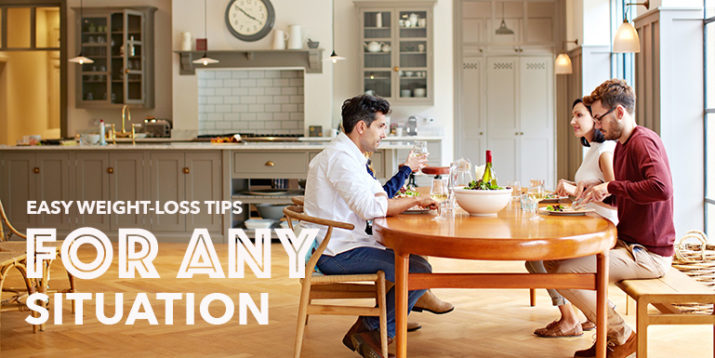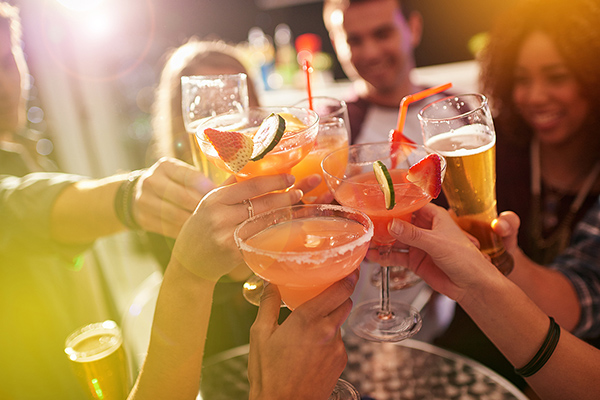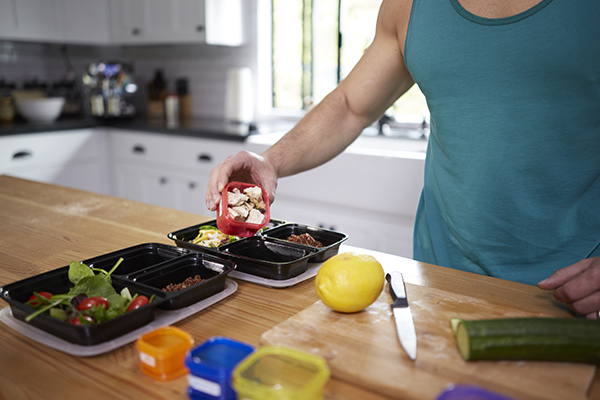6 Expert Tips to Stay On Track in Any Situation

You’re three days into a new weight-loss plan when a friend invites you to her blowout birthday party, complete with a bevy of fried appetizers, pizza, cakes, and unlimited champagne.
You want to stay the course, but you also want to enjoy yourself — and the impulse to down a plate of crispy coconut shrimp is all too real. Sound familiar?
No matter how disciplined you’ve been or how determined you are to lose weight, it’s easy to fall out of step with your weight-loss goals in certain social situations.
For most people, the path to losing weight is anything but linear. “It seems like weight-loss hurdles and setbacks are around every corner,” says Krista Maguire, R.D.
“In fact, [your] own body is programmed to hold on to the weight it has when you restrict energy/calorie intake,” she says.
As if retraining your body to shed extra weight wasn’t difficult enough, you also have to navigate a variety of different social activities and situations — from Sunday brunch to office parties — that can hinder your progress.
Before you learn how to confront and conquer these obstacles, however, it’s important to understand why weight-loss setbacks happen in the first place.

Weight-Loss Setbacks Are Totally Normal
Setbacks can occur for a variety of different reasons, Maguire explains, some of which could include constant exposure to tempting foods (whether in-person or via advertising), lack of accountability, or a lack of knowledge about what is or isn’t healthy.
Another common reason for a setback, according to Kimberly Gomer, M.S., R.D., L.D.N., and the Director of Nutrition at Pritikin Longevity Center + Spa, is setting unrealistic goals when it comes to your diet and exercise regimen.
Of course, “unrealistic” has vastly different meanings for different people, so think of it like this: Any weight-loss plan that’s too difficult for you to maintain or pushes you back to your old habits isn’t going to help facilitate lasting change.
“We all need to find sustainable exercise and eating plans that complement our goals and lifestyle,” says Gomer. “When our eating plans and exercise [routines] are too restrictive they sometimes fail.”
First, Set Attainable Weight-Loss Goals
Before you start trying to lose weight, Gomer says it’s crucial to set attainable short-term goals and create a game plan for making them happen.
Start small, whether that means incorporating one vegetable into every meal or taking a 30-minute walk twice a week, then brainstorm several practical, concrete actions you can take to accomplish that goal.
To stay accountable, Maguire suggests writing out your weight-loss plan and displaying it somewhere visible in your home.
“This makes it seem like more of a contract you’ve agreed to, and [you] are more likely to see it through,” she says.
But remember: Even though discipline is essential to losing weight, it doesn’t have to be a grueling or miserable experience.
In fact, the key to developing long-lasting, positive exercise and eating habits is to make modifications and changes that work for you and help enhance your life.
Maguire says you should look at how you can continue eating what you love but in a healthier way.
“For example, you can still go to your favorite restaurant, but perhaps order a grilled fish dish instead of crispy fried shrimp tacos or have one glass of wine [instead of] a gigantic frozen margarita,” she says.

6 Common Weight-Loss Challenges & How to Navigate Them
Challenge: Finding healthy options at happy hour
Solution: Ditch the fancy cocktails and fill up beforehand
Happy hour is a fun way to unwind from work and catch up with friends and colleagues, but it can also be the perfect storm of temptations.
That’s because alcohol lowers your inhibitions, so when you’re one or two glasses deep, you may be more likely to order a second plate of nachos, especially if you show up to happy hour with an empty stomach.
Even if you can resist the bottomless mozzarella sticks, there’s the alcohol.
“Alcohol has ‘empty calories,'” says Maguire, “meaning that for the amount of energy it provides, it’s pretty much [devoid] of nutritional value.”
Not only that, but research suggests that our bodies register thin liquid calories differently than solid or semi-solid liquids and foods, which is why you can drink several glasses of alcohol without feeling full, she adds.
To avoid overdoing it, nix the sugary cocktails in favor of drinks with fewer calories.
“Stick to wine, single spirits like vodka with a no-calorie mixer, or light beer,” says Lauren Harris-Pincus, M.S., R.D.N., and owner of NutritionStarringYOU.com. “You can lower the calorie content further by having a wine spritzer to increase the volume of your drink,” she adds.
When it comes to food, Harris-Pincus recommends eating a small, healthy snack beforehand to take the edge off your appetite. Look for something packed full of fiber and protein, like a piece of fruit and handful of nuts, or a hard-boiled egg.
Challenge: Eating healthy when you travel
Solution: Pack snacks and do your research
When you’re on a business trip that requires you to be in conference rooms or trade show halls all day, fueling your body with whole, unprocessed foods may seem like a particularly impossible task.
“Fast food, less-than-stellar airport cuisine, and office meeting snacks usually don’t include leafy greens or fruit, ” says Maguire.
That’s why planning ahead is crucial.
“Check online to see what food options are available in your airport terminal and pack some waist-friendly snacks ([like] bananas and apples, nitrate-free salmon or turkey jerky, trail mix, hummus and veggie packets, or a nut butter and jelly sandwich on whole-grain bread) that travel well,” she adds.
You can also pack your favorite Shakeology flavor and shaker cup to mix with water for a satisfying snack loaded with protein.
Or keep a BEACHBAR or two in your bag for snacking emergencies.
For situations where you can’t pack your own food, don’t panic — look for healthy menu items (look for grilled, baked, and steamed foods instead of fried or battered) and make smart modifications, like swapping fries for a green salad or wrapping your burger in lettuce.
Challenge: Social events that involve dining out
Solution: Pick a healthy dish and practice mindful eating
Social activities that revolve around food — like brunch or dinner — can be daunting when you’re trying to lose weight. In addition to a menu filled with tempting options, you may also feel pressure to indulge simply because everyone else is.
Another potential problem?
When you’re eating out with other people, you’re focused on your conversations and not on the food in front of you, Maguire says, which can lead to mindless eating.
Instead of shoveling forkfuls of food into your mouth or reaching for the breadbasket on autopilot, practice mindful eating.
Take small bites, chew your food thoroughly, and slow down so you can savor your meal.
To find a tasty dish that works for your goals, Maguire recommends scoping out the menu online and choosing your meal in advance.
Committing to a healthy dish before you even show up will make you feel more confident and in control of your cravings.
Choosing something more wholesome means you have a little wiggle room to treat yourself if, say, those Parmesan truffle fries are calling your name.

Challenge: Eating healthy at the office
Solution: Meal prep your lunches for the week
Eating nourishing, satisfying foods throughout the workday can increase your energy levels, improve your alertness, and keep you headed in the right direction.
But making smart food choices at the office is way easier said than done, especially when the office kitchen is full of pretzels and mini cookies, with nary a piece of fruit in sight.
“[Many] corporate offices have no healthy options in the vending machine, have a constant cycle of donuts and bagels in the meeting or break room, and may not have healthy restaurants nearby to pick up a decent lunch,” says Maguire.
To avoid reaching for a fist-sized chocolate chip muffin and handful of crackers for lunch, you need to come to work prepared. Enter meal prepping.
Plan one or two meals ahead of time to rotate in and out, and be sure to stock a desk drawer or cabinet with easy, nutrient-rich snacks so you always have something healthy to reach for.
Challenge: Parties at other people’s homes
Solution: Bring your own healthy dish
Going to a barbecue, dinner party, or another food-centric shindig at a friend’s house may mean fewer options that meet your goals.
Events like these — where the food choices are out of your control — can often be a source of anxiety for people trying to lose weight.
Whenever possible, find out what’s being served in advance. If you know there won’t be many healthy options available, Harris-Pincus recommends contributing something of your own.
“Bring a dish that’s fruit- or veggie-heavy so you’ll have at least one item to fill up on that’s lower in calories,” she advises.
Another option is to eat something light and healthy beforehand (try one of these five simple no-cook snacks), then nibble on a small plate of food when you arrive.
“Remember though, that isn’t free reign to keep nibbling,” Maguire warns. “Dish up a small plate, enjoy it, and instead of going back for seconds, start socializing instead.”
Challenge: Wanting to treat yourself while you’re on vacation
Solution: Be mindful of portion sizes
When you’ve taken the time to plan a relaxing trip, save your money, and take two weeks off work, the last thing you want to worry about is your diet. “It’s part of the experience when in another country or even another state to try local specialties,” Maguire says.
But instead of restricting yourself, just be more selective.
“Choose your indulgences carefully and wisely,” says Harris-Pincus.
If you know you’re not a major fan of sweets, skip the famous chocolate-filled pastries so you can dig into something you actually love, like a slice of Neapolitan pizza or side of chips and guac.
Just be aware of portion sizes and do your best to fill up on veggies, fruits, and lean protein as much as possible to offset any less nutritious choices.
Another tip: “Choose things you wouldn’t usually make at home (e.g., order the Ribollita soup in Italy instead of spaghetti with marinara sauce),” says Maguire, “and share plates so you can try multiple dishes without having to commit to the whole plate or bowl.”
The Takeaway
It does take work to stay on track, but meal prepping, planning ahead, and exercising portion control can help you make smart decisions in any situation.
But it’s equally important to cut yourself some slack if you slip.
If you do fall (or jump) off the wagon, don’t give up or wallow in guilt. “Avoid the ‘I blew my diet so I may as well keep eating’ state of mind,” Harris-Pincus says.
One unhealthy or high-calorie choice doesn’t negate all your previous healthy decisions. Remind yourself how far you’ve come, then move forward.
